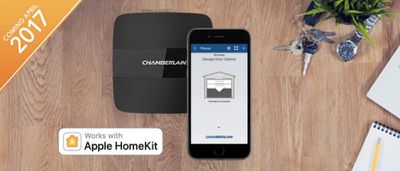 Chamberlain, a connected smart home company that specializes in garage door openers, today announced that it will be introducing Apple HomeKit compatibility to a range of its connected smart home devices. For users already using the company's products in the "MyQ" ecosystem, they will be able to gain HomeKit support through the addition of a new MyQ Home Bridge.
Chamberlain, a connected smart home company that specializes in garage door openers, today announced that it will be introducing Apple HomeKit compatibility to a range of its connected smart home devices. For users already using the company's products in the "MyQ" ecosystem, they will be able to gain HomeKit support through the addition of a new MyQ Home Bridge.
For new users, Chamberlain will launch the all-new Smart Garage Hub, a device that can add smartphone controls to "virtually any brand of garage door opener" that users already own.
Thanks to HomeKit compatibility, users will be able to control their garage door -- and any MyQ connected lighting accessories -- through their iPhone, iPad, iPod touch, or Apple Watch, and even use Siri.

“The value of MyQ technology extends far beyond the garage, but into the daily fabric of families and their lifestyles in the home,” said Cory Sorice, Vice President of Marketing for Connected Products and eCommerce at Chamberlain. “Through our growing product line, new features that add convenience and control, and expanding partnerships with tech leaders, Chamberlain has established itself as the industry’s preeminent smart home innovator.”
Additionally, Chamberlain announced new Smart Light Switches and lamp controls, as well as new features within the MyQ mobile app, including guest accounts and scheduling abilities. On iOS, users will be able to add Touch ID onto the app's startup to ensure an additional layer of security is protecting access to their garage door and lighting controls.
The company said that the MyQ Home Bridge should arrive by April 2017, and the Smart Garage Hub will launch around July 2017. The MyQ Home Bridge will run at a special introductory price of $49.99 (regular $69.99), but there was no mention of how much the Smart Garage Hub will cost.
























Top Rated Comments
[doublepost=1483544575][/doublepost]Just use the Chamberlin app. it works great
From what I understand, and someone correct me if I'm wrong, most Homekit devices don't actually have to have their own proprietary bridge. It's an either/or scenario - you can use HomeKit or you can use their proprietary thing.
Some HomeKit devices do require you to use their own bridge, but it is because the actual things don't support traditional wifi for some technical limitation, and thus use some proprietary system. For example, in some of the lighting systems its inefficient or not cost effective to put a full-blown wifi radio in each bulb, and thus a bridge is used to send signals over power lines.
Also, the term "bridge" has been a misnomer in some situations where it is really rather an add-on module. For example, with garage door openers, often the actual mechanical opener itself is a dumb device and can be expanded to have smart capabilities with an optional plug-in expansion module or card or box of some kind. This is not so much a bridge as it is the actual HomeKit device.
We enjoy It!